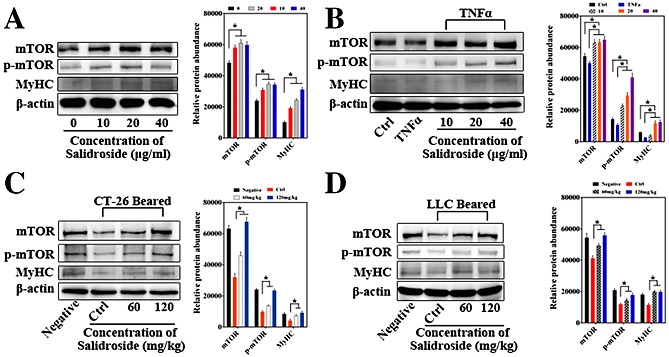Figure 5.

The possible anti‐cachexia mechanism of salidroside. Levels of several critical muscle‐related signal proteins including mTOR, p‐mTOR, and MyHC in gastrocnemius muscle and C2C12 myotubes were determined by western blot. (A) Effect of salidroside on mTOR, p‐mTOR, and MyHC expression in C2C12 myotubes, which were treated by salidroside at different concentrations (10, 20, and 40 µg/mL) without serum for 24 h. (B) C2C12 myotubes were stimulated with TNF‐α (50 ng/mL) for 6 h and then treated by salidroside at different concentrations (10, 20, and 40 µg/mL) for 24 h, and then mTOR, p‐mTOR, and MyHC expressions were determined by western blot. (C, D) Up‐regulation of mTOR, p‐mTOR, and MyHC expression induced by salidroside in gastrocnemius muscle in the model of cachexia induced by CT‐26 and LLC as compared with the control group, respectively. Pairs of total protein were normalized by β‐actin. Correspondingly, quantification of western blot analysis images was performed using Image J software (NIH, Bethesda, MD, USA) from three or more independent experiments and was presented in graphical form (*P < 0.05). Statistics were carried out with a two‐tailed Student's t‐test. Ctrl, the control group; DDP, cisplatin; mTOR, mammalian target of rapamycin; MyHC, myosin heavy chain; TNF‐α, tumour necrosis factor‐α.
